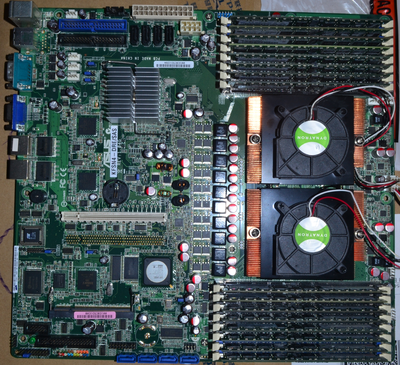Board:asus/kfsn4-dre: Difference between revisions
(Created page with "The KFSN4-DRE is a relatively modern AMD Family 10h motherboard. It is well supported and stable under Coreboot, with all CPUs, RAM, and peripherals functioning normally. Bo...") |
No edit summary |
||
| (22 intermediate revisions by the same user not shown) | |||
| Line 1: | Line 1: | ||
[[File:Kfsn4-dre-mainboard-raptor-devsys.png|400px|thumb|right|ASUS KFSN4-DRE PCB 1.04G at Raptor Engineering.]] | |||
== General Information == | |||
The KFSN4-DRE is a relatively modern AMD K8 / Family 10h motherboard. It is well supported and stable under Coreboot with Family 10h processors, with all CPUs, RAM, and peripherals functioning normally. K8 processors currently require specific RAM configurations to work correctly. | |||
This board is automatically tested by Raptor Engineering's test stand. For more details please visit [[AutoTest/RaptorEngineering]]. | |||
== Installation Notes == | |||
* coreboot can be flashed internally when migrating from the proprietary BIOS. Flashrom can safely reprogram the ROM under Linux. | |||
* When migrating from the proprietary BIOS, after flashing coreboot the CMOS memory should be cleared. Failing to clear the CMOS could result in odd hangs during the boot process. | |||
== Known Issues == | |||
It has recently come to my attention that booting from USB mass storage devices is not possible. Both SeaBIOS and GRUB fail to see any attached flash drives, even though the USB keyboard functions normally. Also, grub is unable to properly initialize the USB keyboard (very slow typing rate, several seconds per character), but SeaBIOS functions normally. Additional debugging is needed by an interested party to resolve these issues. [[User:Tpearson|Tpearson]] ([[User talk:Tpearson|talk]]) | |||
[[Category:Tutorials]] | |||
Latest revision as of 17:01, 11 October 2016

General Information
The KFSN4-DRE is a relatively modern AMD K8 / Family 10h motherboard. It is well supported and stable under Coreboot with Family 10h processors, with all CPUs, RAM, and peripherals functioning normally. K8 processors currently require specific RAM configurations to work correctly.
This board is automatically tested by Raptor Engineering's test stand. For more details please visit AutoTest/RaptorEngineering.
Installation Notes
- coreboot can be flashed internally when migrating from the proprietary BIOS. Flashrom can safely reprogram the ROM under Linux.
- When migrating from the proprietary BIOS, after flashing coreboot the CMOS memory should be cleared. Failing to clear the CMOS could result in odd hangs during the boot process.
Known Issues
It has recently come to my attention that booting from USB mass storage devices is not possible. Both SeaBIOS and GRUB fail to see any attached flash drives, even though the USB keyboard functions normally. Also, grub is unable to properly initialize the USB keyboard (very slow typing rate, several seconds per character), but SeaBIOS functions normally. Additional debugging is needed by an interested party to resolve these issues. Tpearson (talk)